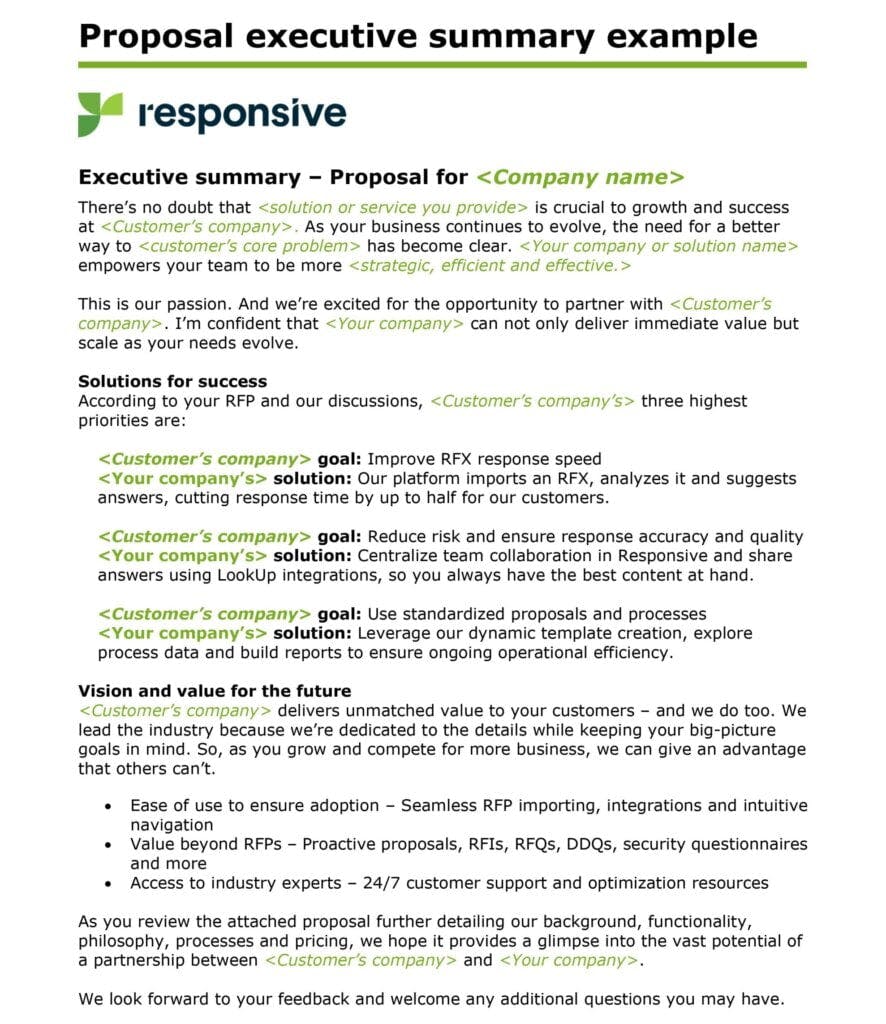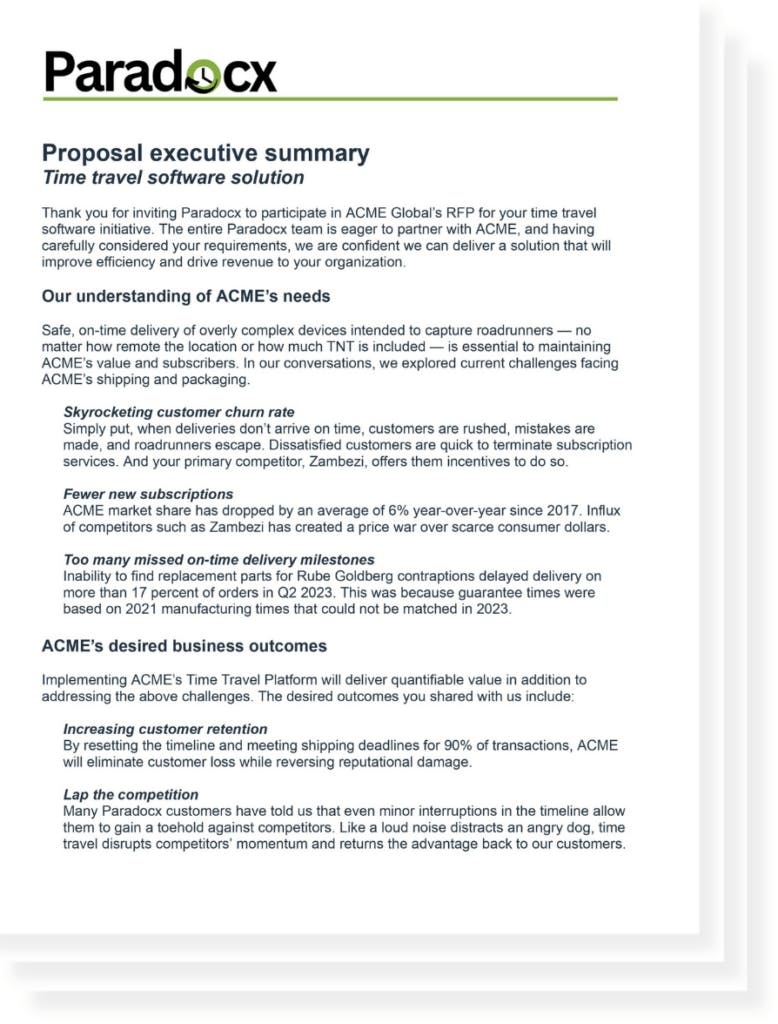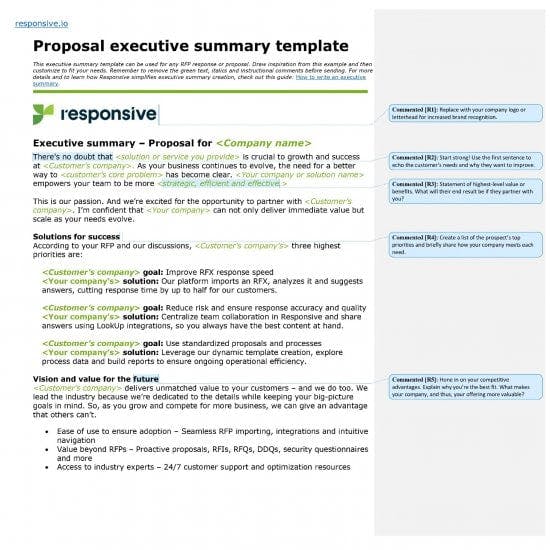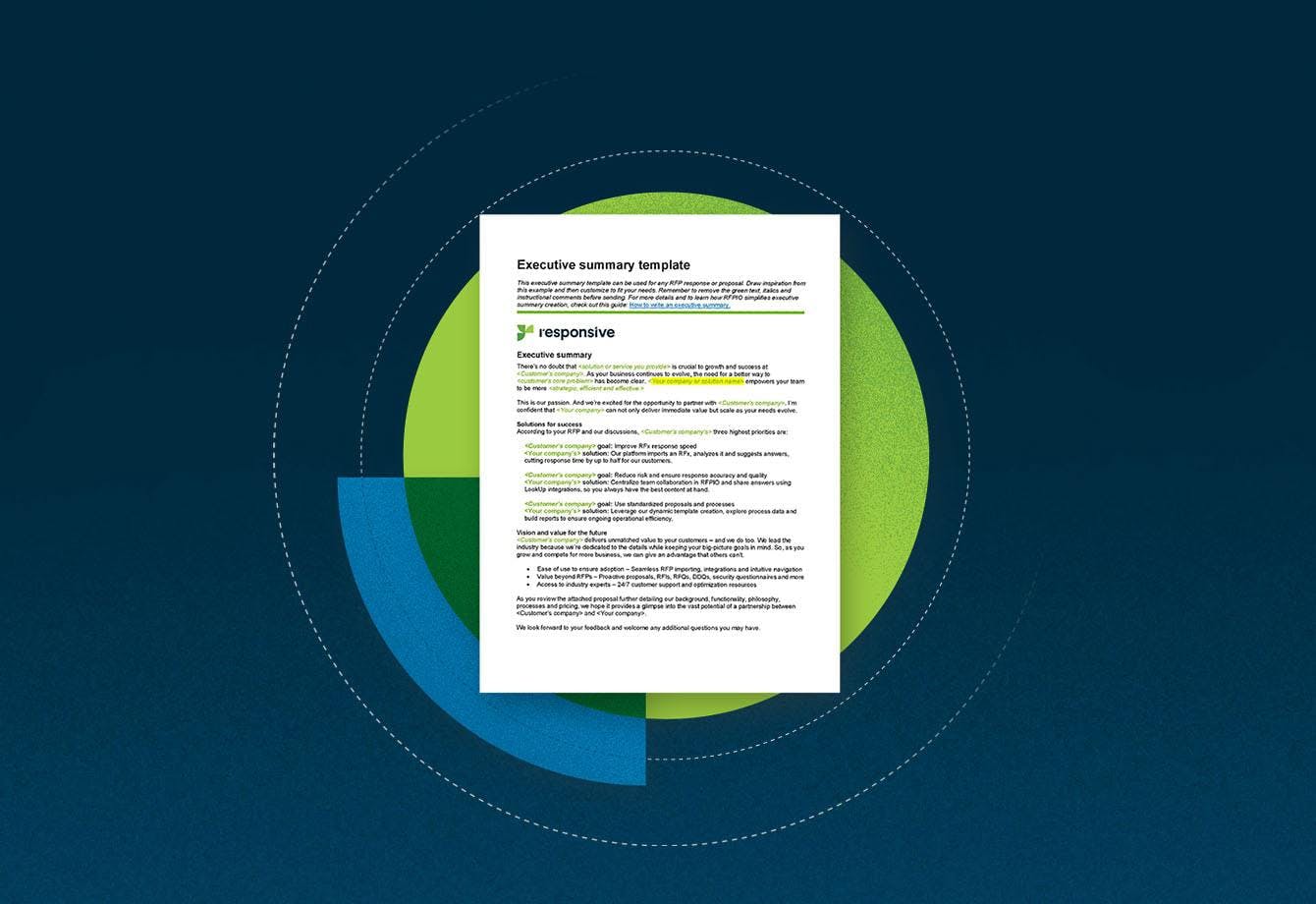Even for the most experienced proposal manager, writing an effective request for proposal executive summary can be a challenge. After all, it needs to be concise, clear and compelling. At the same time, it must convey your deep understanding of the buyer’s unique needs while perfectly capturing how your organization helps them meet their goals and delivers value.
Certainly, it’s no easy feat when you’re staring at a blank screen, feeling the RFP submission deadline approaching minute by minute. So, to avoid facing that pressure, I always recommend checking out a request for proposal executive summary example or two to give yourself a head start.
In this post, we’ll define an RFP executive summary (sometimes called a proposal executive summary) and share how it differs from a cover letter. Then we’ll outline best practices for writing an executive summary for an RFP as well as how to leverage RFP software to make the process faster. Finally, I’ll offer an RFP executive summary example, samples and templates for inspiration to help you get started.
Just need the template? Download our sample RFP executive summary.
NOTE: If you’re looking to summarize your proposal as part of an RFP response you can download our proposal executive summary template.
Proposal executive summary basics
What is a proposal executive summary?
A proposal executive summary is a document that provides a high-level overview of a vendor’s bid, proposal or offer. The executive summary for a proposal is usually just a few pages long and precedes the proposal itself which is much longer and contains lots of in-depth information.
Think of it like a book jacket that includes a teaser blurb. An effective proposal executive summary helps the reader decide if they want to dig in and read more about the vendor’s offer. It contains a synopsis of the buyer’s needs and objectives as well as the vendor’s proposed solution and experience.
The proposal executive summary may also be called an RFP executive summary, RFP executive brief, an executive summary of an RFP or an RFP response executive summary. All of these terms can be used interchangeably.
This short but powerful document also provides additional context for the buyer or decision maker to consider. The intention is to inform and persuade the executive. Most of the time, executives only read this brief instead of the whole RFP, so it has to be right on the money.
Bid Perfect, a proposal consultancy, offers this insight:
“The people who will read your executive summary will be expecting it to summarize the main, compelling elements of your bid, how it meets with their specific objectives and why they should select you as their supplier of choice above all others.”
Why create an executive summary for a proposal?
There’s no way around it, reading an RFP response isn’t everyone’s idea of a good time. Indeed, due to the in-depth nature of RFP questions and responses, it is unrealistic to expect that an executive will have time to read each 50-page proposal from front to back. Despite this, often executive stakeholders are key decision makers.
Luckily, the executive summary of a proposal provides a solution. Because it is typically contained on one or two pages, the summary enables busy stakeholders to understand the vendor’s offer and RFP response in mere minutes.
Beyond saving time, the RFP executive summary gives you the opportunity to address an executive’s concerns that may not have been covered in the RFP questions. Indeed, the reason an executive buys a solution often differs from the reasons that a production team (sales, marketing, IT, etc.) is interested.
Executive teams have big-picture, strategic goals while production teams have daily workflow improvement goals. For example, when we work with sales teams their main objective is to save time and respond to RFPs more efficiently. However, an executive is more interested in how Responsive increases win rates and revenue.
With that in mind, the executive summary of your proposal presents an opportunity to differentiate your organization from your competitors. It is the perfect place to express how your business helps the executive (and organization) meet their goals.
Who writes the executive summary?
Generally, the proposal manager writes the RFP executive summary. However, that is not always the case. Indeed, in small- to medium-sized businesses, sales or marketing may write the proposal executive summary.
Regardless of who is the primary writer of the executive summary, just like with the proposal, it’s a group effort. Be sure to involve anyone who has the best knowledge of the prospect’s needs, the proposal win themes and the proposal content. Many members of your team will contribute to or review the executive summary.
Typical creation and approval process for the proposal executive summary
- Proposal coordinator or manager: Begins the process using an executive summary template for proposals
- Sales, marketing or business development team: Ensures the proposal summary aligns with win themes and customer needs
- Subject matter experts: Contributes to and verifies accuracy
- Marketing – Polishes content and ensures brand alignment
- Executive approver: Reviews the messaging, signs and approves the final RFP executive summary
When should you write the executive summary?
At what point in the RFP response process should the executive summary be written? Well, it depends on who you ask.
Some argue that writing the executive summary of the proposal at the beginning of your proposal timeline helps guide your messaging and process. Conversely, others recommend waiting until the end of your proposal process to create the executive summary for your RFP response. And still others believe it’s best to write the proposal summary as you go.
As you might imagine, this topic is hotly contested among proposal professionals. The difference in timing delivers different benefits:
1. Starting with the proposal executive summary
APMP teaches that writing the entire first draft of your RFP executive summary at the beginning is best. By writing the summary at the beginning, you can incorporate customer insights gained from your discussions to bid or not to bid as well as any win themes that have been identified in the capture management plan.
2. Writing the RFP executive summary as you go
Another option is building your proposal executive summary in tandem with your RFP response. Bid Perfect suggests that the executive summary of your request for proposal should be a living document. Consequently, edits are gradual and continual as the team works on the proposal: “We believe that there should be no fixed time for writing it but that we are always writing our executive summary throughout the life of the bid preparation phase.”
3. Creating the RFP executive summary as your last step
Finally, Boardroom Metrics recommends writing the RFP executive summary at the end, saying,
“… write it at the end, once all the other work has been completed on the response. That way you will have access to all the thinking that’s been done on preparing the request for proposal – thinking on the issuer, their needs and your solution.”
Ultimately, each of these approaches works and only you can decide which of the three is best for you. Consider your organization’s unique RFP response process and determine which strategy fits.
What’s the difference between an RFP executive summary and a cover letter?
At first glance, it may seem like the executive summary and an RFP cover letter are the same thing. After all, they both precede the full RFP response and take only one page. In addition, often, the RFP issuer doesn’t establish requirements or parameters for either document. So it’s easy to see why the two get confused. However, each document has a unique purpose and requires a different approach.
Executive summary vs. cover letter
Request for proposal executive summary
To put it simply, the executive summary is a high-level overview of your proposal. Its purpose is to enable the reader to quickly understand key elements of the proposal. Think of it as a blurb on the back of a book. Without having to read the entire thing, anyone can read the executive summary and understand the highlights of your proposal.
RFP response cover letter
On the other hand, the RFP cover letter is more like a greeting and introduction. Consequently, it can be slightly less formal than the executive summary. A great cover letter will give the reader a positive first impression of your company and encourage them to dig into your full proposal.
An effective RFP executive summary will:
- Help a busy executive or stakeholder get up to speed
- Predicts the benefits the customer can expect from your partnership
- Summarize the most important parts of your proposal
- Offer additional insight on key differentiators
A compelling cover letter will:
- Be addressed to the evaluator(s) and set the stage for the proposal
- Express an understanding of the business and their needs
- Convey your desire to be a true partner and why you’re a good fit
- Create a genuine, human connection
Despite their differences, when well written, both the executive summary and cover letter can help make your proposal more memorable. However, it is important to remember that neither document is a sales pitch about your business. Indeed, both should be customer-centric and benefit focused.
Which comes first, the proposal executive summary or cover letter?
Another common question that comes up when discussing proposal executive summaries and cover letters is which comes first when presenting your final RFP. Again, the answer to this question depends on who you ask. One easy way to decide is to ask, ‘If a decision maker only reads one of these two pages, which would you pick?’ In most cases, we believe the answer is the executive summary.
Suggested order of RFP documents
- Cover page
- Executive summary
- Cover letter
- RFP response
- Pricing (if not included in the RFP questions)
- Supporting documentation
- Terms and conditions
How to write an RFP executive summary
One effective strategy for writing an executive summary breaks down the content into four sections: needs, outcomes, solution, and evidence. Developed by Dr. Tom Sant, the author of Persuasive Business Proposals, this approach goes by the acronym NOSE. Your executive summary should address these four areas:
- Needs: Spell out your understanding of the prospect’s challenges
- Outcomes: Confirm the results they expect to achieve
- Solution: Explore how you solve the problem
- Evidence: Build trust by sharing results from customers with similar needs
According to Dr. Sant, by organizing your executive summary to align with NOSE, you’ll address the main three questions executives ask:
- Does the proposed solution meet the need?
- Is it worth the investment of resources and time?
- Can they really deliver?
Many salespeople make the mistake of focusing more on “summary” than “executive.” Remember that your proposal executive summary shouldn’t be a table of contents for the RFP response. It should speak to the executive perspective.
RFP executive summary best practices
Now that you have all the basics down, let’s dig into some best practices for your request for proposal executive summary.
Make your message customer-centric
Similar to your RFP response, the focus of the executive summary should be the customer. As you write, keep them in mind. Make sure that you address their criteria, needs and goals. Hone in on the specific things they indicated are a priority and explain how your solution delivers value to those areas.
Your message should resonate with executives and stakeholders alike. If possible, tell a memorable and influential client success story that brings your value to life. Alternatively, you can convey your strategic vision for your partnership. In addition, clearly and succinctly reiterate the key points and differentiators in your proposal.
Use the recipient’s actual name whenever possible. It makes recipients feel important and personally attended to when they see their name on the front page. Additionally, aim for a 3:1 ratio of recipient company name versus your company name.
Use dynamic verbs and active voice
Sadly, the most popular title for an executive summary is “Proposal for Prospect Company.” Use the title or subtitle as an opportunity to capture the executive’s attention. “Increasing lead-generation…,” or “Visualizing revenue forecasting…,” or “Streamlining cloud storage…” or whatever it is that your solution is going to do for them.
And, just like in your RFP responses, remember to use active voice whenever possible. This practice makes your RFP executive summary more direct and impactful.
Express empathy and understanding
Use your proposal executive summary to convey your understanding of the company’s needs — remember the ‘N’ of the NOSE approach above. Work with the sales and business development teams to gather this information.
As you enumerate the prospect’s objectives, limit your list to between three and five points prioritized by importance. If your list is longer you risk making later bullets seem trivial. As you articulate your understanding in the proposal executive summary, you relieve any concerns an executive approver may have as the holder of the purse strings.
Be brief
Be concise and make a big impact using as little space as possible. Review each sentence critically. Does it convey something new, relevant to the reader and memorable? The RFP executive summary isn’t the place to get into the details of every aspect of your offer. It should be easy to scan and understand.
Remember, the reviewer is likely reading a summary from every prospective vendor trying to keep them all straight. Your brevity will not only make your executive summary more memorable, but the reviewer will appreciate it.
Leverage your knowledge library
The content library in your proposal management platform doesn’t just have to be for RFP responses. You can also store executive summary content in the same way. We all know the feeling of satisfaction when we perfectly articulate a value proposition or find a clever way to point out a differentiator. Don’t miss an opportunity to use that awesome content in your next RFP response. Use tags and categorization to save sections of text for future executive summaries.
It’s worth noting that if you use RFP software, you can automate much of your executive summary construction. You can use a template for consistency, gather the responses you need, and leverage Responsive AI to summarize your content.
What used to take hours, you can now accomplish in minutes. However, don’t forget to remove any customer information before saving it to your knowledge library. And just like your RFP or proposal templates, always remember to customize and review before sending.
Make sure it can stand alone
Write your executive summary as if the reader has limited knowledge of the original RFP or your corresponding proposals. The document should be easy to understand on its own.
Outlining high-level benefits is key. Remember that the executive summary may be the only thing that some decision-making stakeholders read. So make sure you make it count.
Follow directions
This may seem basic, but it’s not uncommon for procurement teams to disqualify vendors that didn’t follow instructions. For example, we’ve seen some RFPs that include executive summary guidelines like page limits, topics to be covered or format. If instructions are provided, be sure that you’ve read them carefully and follow them closely — a proposal compliance matrix can help.
Proposal executive summary examples
Want to see an executive summary for an RFP example? You’re not alone. As with most writing, starting is the hardest part. If you find yourself frozen, staring at a blank page check out these RFP executive summary examples to help.
Simple RFP executive summary example
This proposal executive summary example is one that we have used ourselves. You’ll see the approach we use when creating an executive summary for an RFP we’ve answered. The customer wanted a solution that would improve and automate their manual RFP response process, deliver value quickly and grow with them.
You’ll see in this executive summary for an RFP example that we addressed each of the customer’s needs. In addition, we touched on several of our key differentiators. To conclude, we support our statements with a proof point and a statement of what the customer can expect when they partner with us. You can jump to the next section to download this example as a template.

Creative extended proposal executive summary example
This imaginative RFP executive summary example plays out a sample scenario between fictional companies called “Paradocx” (the prospective vendor) and “ACME” (the buyer). If you’re familiar with Road Runner and Wile E. Coyote, you may recognize a few of the themes in this example. Additionally, this example follows the NOSE approach described above. As you read along, see how the proposal identifies the needs, outcomes, solution and evidence.

RFP executive summary template
Executive summary template for a proposal
You can download this RFP executive summary template for a proposal in Word and customize it to meet your needs. In addition, the request for proposal cover letter template provides suggestions in the comments with additional guidance so anyone can quickly create an impactful executive summary.

Additional RFP executive summary examples and resources
- APMP — RFP executive summary template
- APMP California Chapter Presentation — Making it count: The effective executive summary
- Bid Perfect Guide — Writing an effective executive summary
The value of a proposal executive summary
We answer a lot of RFPs here at Responsive. And, we have a saying, "A proposal by itself is unlikely to win the deal, but a bad proposal can certainly lose it." The same can be said for an executive summary.
It’s been my experience that very few organizations or individuals get any training on writing effective RFP executive summaries. Hence, there’s often a lot of inconsistency from one sales person to the next — which makes it difficult to identify what’s working. That’s one area where the Responsive Platform shines. With dynamic templates, simplified collaboration and content governance, you can create consistent, data-driven RFP executive summaries in minutes.
Of course, every executive summary of an RFP is a little different. But with the right process and tools, you’ll be far more likely to be successful. And, as your experience grows, expands and improves, so too will the quality of your executive summaries.

